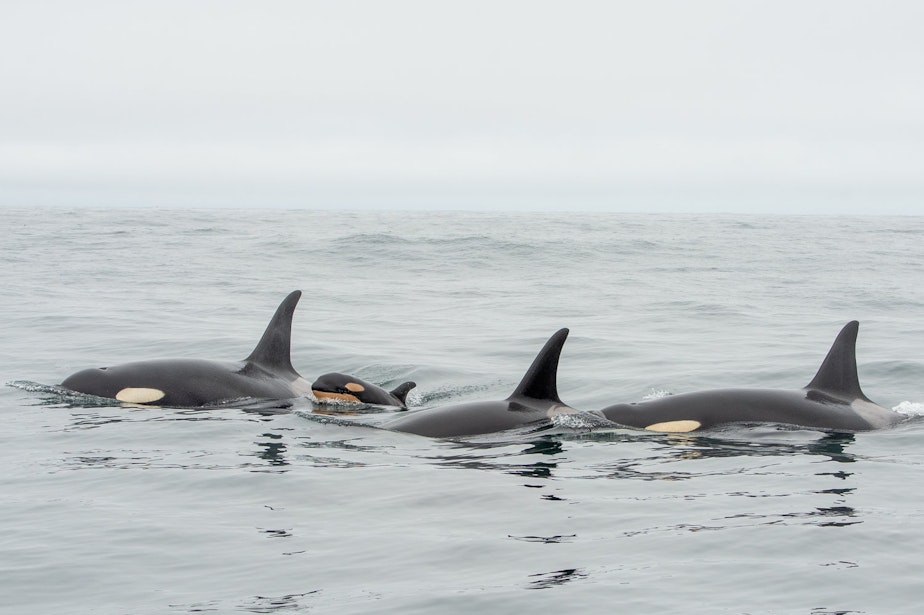Ping! Orcas threatened by sonar plan, Inslee and enviros tell Navy

The U.S. and Canadian navies have long done sonar testing in orca waters.
Now, environmental groups and Washington Gov. Jay Inslee are fighting a U.S. Navy proposal that could harm up to 51 endangered orcas a year with piercing sounds of underwater sonar.
The U.S. Navy’s plan for testing and training on the West Coast would send loud underwater pings into orca habitat, as close as 100 yards to the endangered whales, for another seven years.
Navy sonar can be hard to listen to.
Navy sonar pings
A U.S. Navy destroyer's sonar pings off San Juan Island in January 2016, courtesy Scott Veirs / Beam Reach.
This underwater recording of sonar emitted by a U.S. Navy destroyer in 2016 was shared by Seattle oceanographer Scott Veirs. It was taken from the west side of San Juan Island
Battleships and orcas both use sound to hunt, which makes Navy sonar a problem for the sleek black-and-white predators. The noise makes it hard for orcas to echolocate their prey and communicate with other orcas.
While the US Navy proposal includes steps to protect whales from the impacts of sonar and underwater explosions, it would allow sonar testing as close as 100 yards from the endangered orcas. Shipboard spotters would be on the lookout for orcas getting too close.
The plan would allow an annual 51 “takes”— a term referring to disturbances or harm of an endangered species — of southern resident orcas. For example, a single orca’s feeding or other behaviors might be disrupted 51 times, or 51 orcas might be disturbed once a year.
The southern resident killer whales are down to 72 animals, with at least three of them known to be pregnant this summer.
The National Marine Fisheries Service, in its preliminary approval of the proposal, found that the disturbances would be brief (“between minutes and hours”) and would not cause serious injuries or death —the plan would have a “negligible impact.”
“Even acknowledging the small and declining stock size of the Eastern North Pacific Southern Resident stock, this low magnitude and severity of harassment effects is unlikely to result in impacts on individual reproduction or survival, much less annual rates of recruitment or survival of any of the stocks,” the agency found.
“Those distances need to increase to provide a greater protection zone around the whales,” said Monika Wieland Shields with the Orca Behavior Institute on San Juan Island. “State law is whale watching can’t even happen within 300 yards.”
Her group was one of 29 environmental groups to oppose the proposal.
The heads of five Washington state agencies called for boosting the no-sonar zone to 1,000 yards from the southern residents. They also called for the Navy to consult real-time whale alert systems rather than depending solely on human observers to spot nearby whales.
"The Navy is acutely aware of the challenges faced by the southern resident killer whales," planner John Mosher at Naval Air Station Whidbey Island said. "Everything we do gets a strong focus on how we can minimize effects on that species."
Mosher said the Navy powers its sonar down 25% when a marine mammal is spotted 1,000 yards away and another 25% if it's within 500 yards.
The state officials called the plan “gross neglect” of federal responsibilities under endangered species and marine mammal protection laws.
Difficulty finding enough to eat is one of the biggest problems for the endangered orcas.
Dwindling returns of Chinook salmon from Canada's Fraser River and rivers pouring into Puget Sound have led the orcas to largely abandon their core habitat off San Juan Island.

“As the southern residents have been spending less time in the Salish Sea, they’re spending a corresponding increased amount of time on the outer coast of Washington state. And that’s where a lot of these proposed testing activities would take place,” Wieland Shields said.
The Navy training and testing proposal covers the West Coast from northern California to the Canadian border and a small area near Ketchikan, Alaska.
Mosher said some new protective measures are "in the works" and that the Navy was eager to work with organizations in the U.S. and Canada that issue alerts on whales' locations.
"We are taking, I think, extreme measures to be protective and minimize those effects," he said. "We do need to train. We do need to test with our equipment."
National Marine Fisheries Service spokesperson Michael Milstein, who declined an interview request, said in an email that the agency aimed to make a final decision on the Navy plan by November.
This story has been updated to include comments from U.S. Navy officials.




